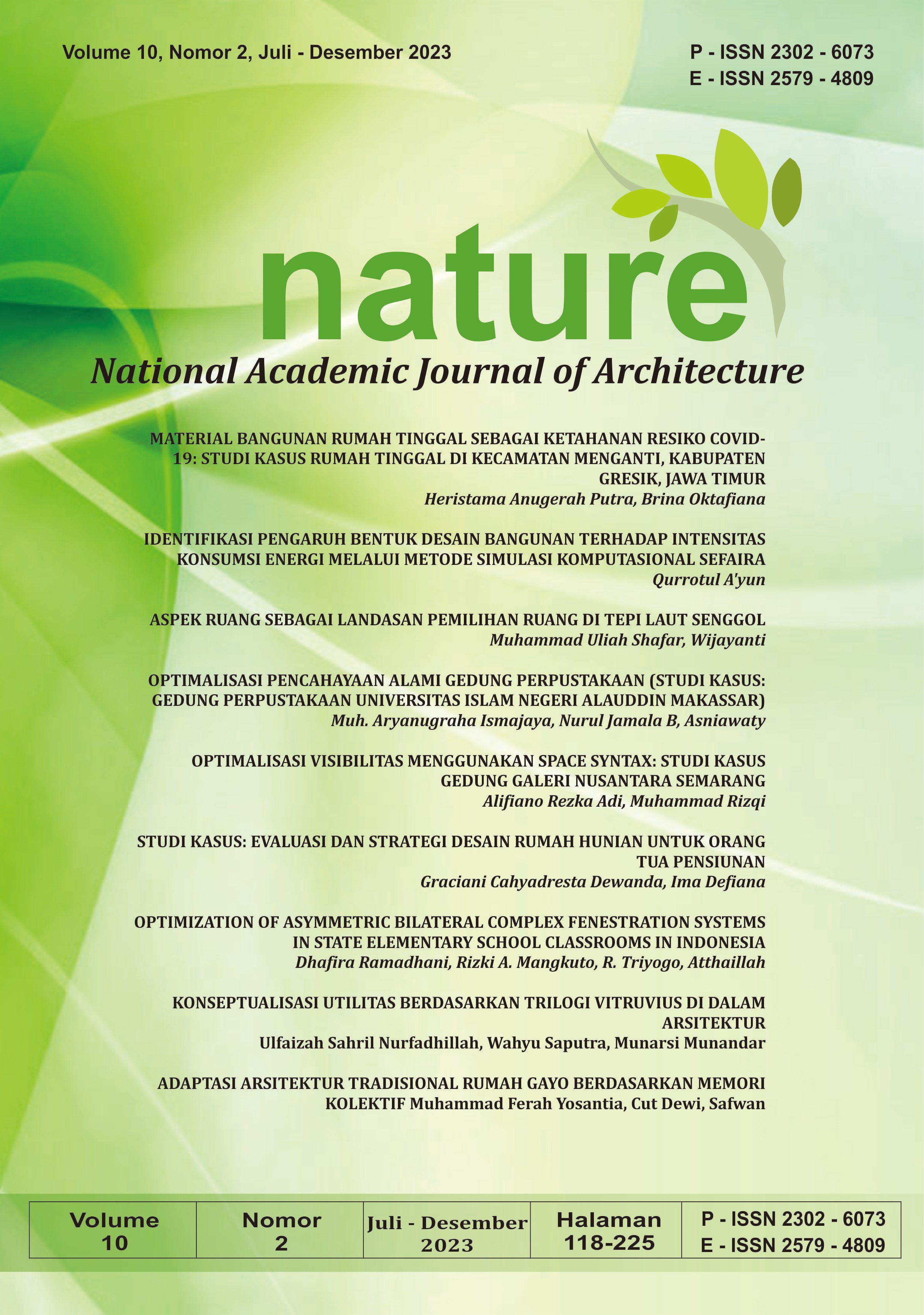KONSEPTUALISASI UTILITAS BERDASARKAN TRILOGI VITRUVIUS DI DALAM ARSITEKTUR
Abstract
This study aims to delve deeper into the concept of utility (function) based on Vitruvius's trilogy in architecture. The research employs a literature review, focusing on the perspectives of experts, architects, and findings from scholarly articles discussing or mentioning the concept of utility (function) in architecture. These insights are then synthesized to gain a more profound understanding of the concept of utility in architecture. The literature review draws from relevant books and scholarly articles aligned with the study's focus. The study's results indicate that the concept of utility or function in architecture extends beyond mere physical or material dimensions, as outlined by Vitruvius. Utility is the result of the interaction between the environment and human needs. In the concept of function, two critical aspects need to be understood: internal aspects encompassing physical, psychological, structural, and activity-related functions, and external aspects covering economic, aesthetic, cultural, social, expressive, and historical functions. Both aspects focus on enhancing the quality of life. Function in architecture not only influences the quality of life but also connects essential elements to create architectural works considered ideal from a human perspective. There is an intrinsic relationship between utility, venustas, and firmitas that shapes the essence of architectural utility or function itself.
Downloads
References
Alberti, L. B. (1986). The Ten Books of Architecture, the 1755 Leoni Edition. Dover Publication, Inc.
Ashadi, A. (2022). Meaning of Function in Architecture: Interpret Insider and Outsider Function. International Conference on Engineering, Construction, Renewable Energy, and Advanced Materials, 0(0), 1–6.
Bhatt, M., Hois, J., & Kutz, O. (2010). Modelling Form and Function in Architectural Design. SFB/TR 8 Spatial Cognition, 27, 1–27.
Boschi, N., & Pagliughi, L. M. (2002). Quality of Life: Meditations on People and Architecture. Indoor Air 2002, 953–958.
Broadbent, G., Bunt, R., & Jencks, C. (1980). Signs, Symbols and Architecture. John Wiley & Sons Inc.
Brook, D. (2014). Structure, Sign and Function: Selected Essays by Jan Mukarovsky; John Burbank; Peter Steiner. Leonardo, 14(2), 161–162.
Burhany, N. R. (2010). Dialog Kritis Trilogi Vitrivius Vs. Dwilogi Mangunwijaya. Mektek, X (1), 54–61.
Gharibpour, A. (2012). Definition of Architecture (Rethinking the Vitruvian Triad). International Journal of Architecture and Urban Development, 2(4), 51–58.
Greenhalgh, P. (1990). Modernism in Design. Reaktion Books Ltd.
Halim, M., Sharfina, S. E., Rachman, A. P., Budhiari, N. M. D. S., Kasuma, I. P. A. W., Susanti, E., & Suwantara, I. K. (2020). VISUAL (Vertikalitas Arsitektur Tradisional Bali) pada Rumah Susun di Kawasan Sarbagita. Nuansa Cendekia.
Harisah, A., & Sudaryono. (2005). Eklektisisme dan Gaya Arsitektur Eklektik di Amerika Serikat: Kajian Konsep Dan Prinsip-Prinsip Perancangan. Universitas Gadjah Mada.
Hariyono, P. (2014). Arsitektur Humanistik Menurut Teori Maslow. Seminar Nasional Sains Dan Teknologi, 26–31.
Haryadi, & Setiawan, B. (2014). Arsitektur, Lingkungan dan Perilaku Pengantar ke Teori, Metodologi dan Aplikasi. Gadjah Mada University Press.
Hendrix, J. S. (2013). The Contradiction Between Form and Function in Architecture. SAJAH, 27(1), 9–28. https://doi.org/10.4324/9780203070932
Istanto, F. H. (1999). Arsitektur “Guna Dan Citra” Sang Romo Mangun in Memorian: Yusuf Bilyarta Mangunwijaya. DIMENSI (Jurnal Teknik Arsitektur), 27(2), 40–47. http://puslit2.petra.ac.id/ejournal/index.php/ars/article/view/15716
Johnson, P. A. (1994). The Theory of Architecture: Concepts, Themes & Practices. Van Noshard Reinhold.
Klassen, W. W. (1990). Architecture and Philosophy: Phenomenology, Hermeneustics, Deconstruction. University of San Carlos.
Lang, J., & Moleski, W. (2016). Functionalism revisited: Architectural theory and practice and the behavioral sciences. Routledge. https://doi.org/10.4324/9781315254838
Laurens, J. M. (2004). Arsitektur & Perilaku Manusia. Grasindo.
Ligo, L. L. (1984). The Concept of Function in Twentieth-Century Architectural Critism. Dissertation. UMI Research Press.
Mangunwijaya, Y. B. (2013). Wastu Citra (Revised). Gramedia Pustaka Utama.
Morgan, M. H. (1914). Vitruvius The Ten Books on Architecture. Harvard University Press.
Nornberg-Schultz, C. (1963). Intentions in Architecture. Allen & Unwin.
Poerschke, U., & Führ, E. (2012). Function, Purpose, Use in Architecture and Urbanism. International Journal of Architectural Theory, 17(32), 5–8.
Preiser, W. F. E., Rabinowitz, H. Z., & White, E. T. (1988). Post-occupancy evaluation. Van Nostrand Reinhold.
Roosandriantini, J. (2019). Terapan Trilogi Vitruvius Dalam Arsitektur Nusantara, Studi kasus pada Arsitektur Wae Rebo dan Toraja. EMARA Indonesian Journal of Architecture, 4(2), 77–84.
Scott, G. (1914). The Architecture Of Humanism A Study and The History of Taste. Houghton Mifflin Company.
Smith, K. (2012). Introducing Architectural Theory. Routledge.
Snyder, J. C., & Catanese, A. J. (1997). Pengantar Arsitektur. Erlangga.
Sopandi, S. (2013). Sejarah Arsitektur: Sebuah Pengantar. Gramedia Pustaka Utama.
Wenger, N. K., Mattson, M. E., Furberg, C. D., & Elinson, J. (1984). Assessment of Quality of Life in Clinical Trials of Cardiovascular Therapies. The American Journal Of Cardiology, 54, 908–913. https://doi.org/10.1002/sim.4780101207
Copyright (c) 2023 Ulfaizah Sahril Nurfadhillah, Wahyu Saputra, Munarsi Munandar

This work is licensed under a Creative Commons Attribution-ShareAlike 4.0 International License.
By submitting your manuscript to our journal, you are following Copyright and License











